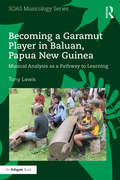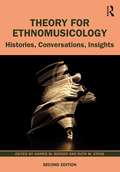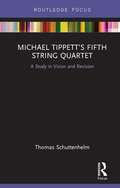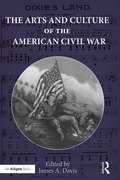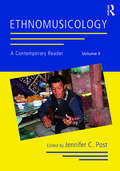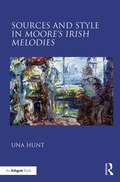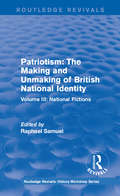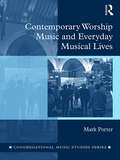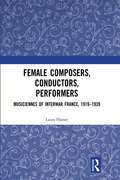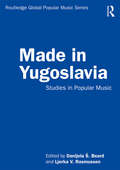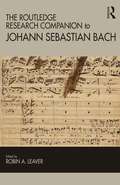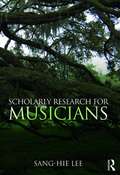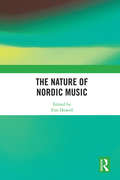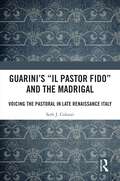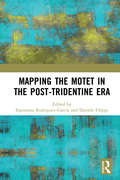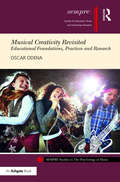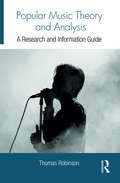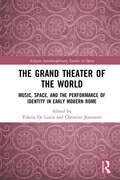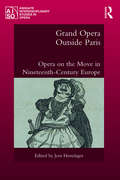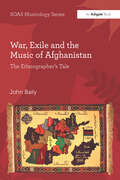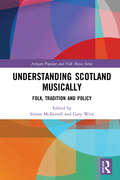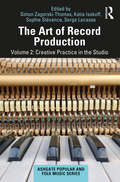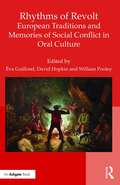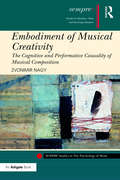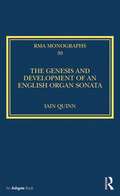- Table View
- List View
Becoming a Garamut Player in Baluan, Papua New Guinea: Musical Analysis as a Pathway to Learning (SOAS Musicology Series)
by Tony LewisThe garamut is a log idiophone that is found in many of the coastal and island areas of Papua New Guinea. The instrument’s primary use is as a speech surrogate and in some regions the garamut is also used in large ensembles to play complex music for dancing. In Baluan Island, within the Manus Province, this style of garamut playing is comparatively highly developed. This book follows the author’s processes and methods in learning to play the music of the garamut, to the level at which he became accepted as a garamut player by the people of Baluan. Lewis argues that analysis is essential in learning to play the rapid tempi and complex rhythms of Baluan garamut music, in a cultural context where there is no formal teaching process for the music. The transcription and analysis of the Baluan garamut repertoire is the centrepiece of this study, reflecting the cognitive structures of the learning process, and revealing the inner workings of the music’s complexity as well as a striking beauty of form and structure. The book concludes with reflections on the process of a ‘cultural outsider’ becoming a garamut player in Baluan and on the role of musical analysis in that process, on the ethnomusicologist’s role in transmission of the music, and on the nature of continuity and change in a musical society such as Baluan.
Theory for Ethnomusicology: Histories, Conversations, Insights
by Harris M. Berger Ruth M. StoneTheory for Ethnomusicology: Histories, Conversations, Insights, Second Edition, is a foundational work for courses in ethnomusicological theory. The book examines key intellectual movements and topic areas in social and cultural theory, and explores the way they have been taken up in ethnomusicological research. New co-author Harris M. Berger and Ruth M. Stone investigate the discipline’s past, present, and future, reflecting on contemporary concerns while cataloging significant developments since the publication of the first edition in 2008. A dozen contributors approach a broad range of theoretical topics alive in ethnomusicology. Each chapter examines ethnographic and historical works from within ethnomusicology, showcasing the unique contributions scholars in the field have made to wider, transdisciplinary dialogs, while illuminating the field’s relevance and pointing the way toward new horizons of research. New to this edition: Every chapter in the book is completely new, with richer and more comprehensive discussions. New chapters have been added on gender and sexuality, sound and voice studies, performance and critical improvisation studies, and theories of participation. New text boxes and notes make connections among the chapters, emphasizing points of contact and conflict among intellectual movements.
Michael Tippett’s Fifth String Quartet: A Study in Vision and Revision
by Thomas SchuttenhelmThomas Schuttenhelm provides a detailed account of the events leading up to and throughout the compositional process associated with Michael Tippett’s Fifth String Quartet and a comprehensive analysis of the entire quartet. The commentary discusses this work in the context of Tippett’s creative development and places it within the historical context of the genre of the string quartet. The commentary includes interviews with the members of the Lindsay String Quartet, who premiered the work, as well as previously unpublished letters from the composer and interviews with Tippett in which he discusses the quartet in detail. Special attention is given to Tippett’s preliminary attempts, which were only recently discovered (2011) and to the evidence that suggests he altered the original ending. Included are images from the composer’s sketchbooks and manuscripts, as well as the original beginning and the altered ending.
The Arts and Culture of the American Civil War
by James A. DavisIn 1864, Union soldier Charles George described a charge into battle by General Phil Sheridan: "Such a picture of earnestness and determination I never saw as he showed as he came in sight of the battle field . . . What a scene for a painter!" These words proved prophetic, as Sheridan’s desperate ride provided the subject for numerous paintings and etchings as well as songs and poetry. George was not alone in thinking of art in the midst of combat; the significance of the issues under contention, the brutal intensity of the fighting, and the staggering number of casualties combined to form a tragedy so profound that some could not help but view it through an aesthetic lens, to see the war as a concert of death. It is hardly surprising that art influenced the perception and interpretation of the war given the intrinsic role that the arts played in the lives of antebellum Americans. Nor is it surprising that literature, music, and the visual arts were permanently altered by such an emotional and material catastrophe. In The Arts and Culture of the American Civil War, an interdisciplinary team of scholars explores the way the arts – theatre, music, fiction, poetry, painting, architecture, and dance – were influenced by the war as well as the unique ways that art functioned during and immediately following the war. Included are discussions of familiar topics (such as Ambrose Bierce, Peter Rothermel, and minstrelsy) with less-studied subjects (soldiers and dance, epistolary songs). The collection as a whole sheds light on the role of race, class, and gender in the production and consumption of the arts for soldiers and civilians at this time; it also draws attention to the ways that art shaped – and was shaped by – veterans long after the war.
Ethnomusicology: A Contemporary Reader, Volume II
by Jennifer C. PostEthnomusicology: A Contemporary Reader, Volume II provides an overview of developments in the study of ethnomusicology in the twenty-first century, offering an introduction to contemporary issues relevant to the field. Nineteen essays, written by an international array of scholars, highlight the relationship between current issues in the discipline and ethnomusicologists’ engagement with issues such as advocacy, poverty and social participation, maintaining intangible cultural heritages, and ecological concerns. It provides a forum for rethinking the discipline’s identity in terms of major themes and issues to which ethnomusicologists have turned their attention since Volume I published in 2005. The collection of essays is organized into six sections: Property and Rights Applied Practice Knowledge and Agency Community and Social Space Embodiment and Cognition Curating Sound Volume II serves as a basic introduction to the best writing in the field for students, professors, and music professionals, perfect for both introductory and upper level courses in world music. Together with the first volume, Ethnomusicology: A Contemporary Reader, Volume II provides a comprehensive survey of current research directions.
Sources and Style in Moore’s Irish Melodies
by Una HuntOnce regarded as Ireland’s national bard, Thomas Moore's lasting reputation rests on the ten immensely popular collections of drawing-room songs known as the Irish Melodies, published between 1808 and 1834. Moore drew on anthologies of ancient music, breathing new life into the airs and bringing them before a global audience for the very first time. Recognizing the unique beauty of the airs as well as their symbolic significance, these qualities were often interwoven into the verses providing potent political commentary along with a new cultural perspective. At home and abroad, Moore’s Melodies created a realm of influence that continued to define Irish culture for many decades to come. Notwithstanding the far-reaching appeal and success of the collections, Moore has only recently begun to receive serious attention from scholars. Una Hunt provides the first detailed study of Moore’s Irish Melodies from a combined musical and literary standpoint by drawing on a practical understanding and an unrivalled performance experience of the songs. The initial two chapters contextualize Moore and his songs through a detailed examination of their sources and style while the following chapters concentrate on the collaborative work provided by the composers Sir John Stevenson and Henry Rowley Bishop. Chapters 5 and 6 reappraise musical sources and Moore’s adaptation of these, supported and illustrated by the Table of Sources in the Appendix.
Routledge Revivals: Volume III: National Fictions (Routledge Revivals: History Workshop Series)
by Raphael SamuelFirst published in 1989, this is the third of three volumes exploring the changing notions of patriotism in British life from the thirteenth century to the late twentieth century and constitutes an attempt to come to terms with the power of the national idea through a historically informed critique. This volume studies some of the leading figures of national myth, such as Britannia and John Bull. One group of essays looks at the idea of distinctively national landscape and the ways in which it corresponds to notions of social order. A chapter on the poetry of Edmund Spenser explores metaphorical representations of Britain as a walled garden, and the idea of an enchanted national space is taken up in a series of essays on literature, theatre and cinema. An introductory piece charts some of the startling changes in the image of national character, from the seventeenth-century notion of the English as the most melancholy people in Europe, to the more uncertain and conflicting images of today.
Contemporary Worship Music and Everyday Musical Lives (Congregational Music Studies Series)
by Mark PorterWhilst Contemporary Worship Music arose out of a desire to relate the music of the church to the music of everyday life, this function can quickly be called into question by the diversity of musical lives present in contemporary society. Mark Porter examines the relationship between individuals’ musical lives away from a Contemporary Worship Music environment and their diverse experiences of music within it, presenting important insights into the complex and sometimes contradictory relationships between congregants’ musical lives within and outside of religious worship. Through detailed ethnographic investigation Porter challenges common evangelical ideals of musical neutrality, suggesting the importance of considering musical tastes and preferences through an ethical lens. He employs cosmopolitanism as an interpretative framework for understanding the dynamics of diverse musical communities, positioning it as a stronger alternative to common assimilationist and multiculturalist models.
Female Composers, Conductors, Performers: Musiciennes of Interwar France, 1919-1939
by Laura HamerDrawing upon extensive archival research, interview material, and musical analysis, Female Composers, Conductors, Performers: Musiciennes of Interwar France, 1919–1939 presents an innovative study of women working as professional musicians in France between the two World Wars. Hamer positions the activities, achievements, and reception of women composers, conductors, and performers against a contemporary socio-political climate that was largely hostile to female professionalism. The musical styles and techniques of Marguerite Canal, Jeanne Leleu, Germaine Tailleferre, Yvonne Desportes, Elsa Barraine, and Claude Arrieu are discussed with reference to significant works dating from the interwar period. Hamer highlights the activities of Jane Evrard and her Orchestre féminin de Paris as well as the reception of the Orchestra of the Union des Femmes Professeurs et Compositeurs de Musique, a contemporary pro-suffrage organisation that was dedicated to defending the collective interests of musiciennes and campaigning for their employment rights. Beyond women composers and conductors, Hamer also sheds light on female performers and their contribution to the interwar early music revival.
Made in Yugoslavia: Studies in Popular Music (Routledge Global Popular Music Series)
by Ljerka V. Rasmussen Danijela S. BeardMade in Yugoslavia: Studies in Popular Music serves as a comprehensive and thorough introduction to the history, sociology, and musicology of popular music in Yugoslavia and the post-Yugoslav region across the twentieth and twenty-first centuries. The book consists of chapters by leading scholars and covers the major figures, styles, and social contexts of music in the region that for most of the past century was known as Yugoslavia. Exploring the role played by music in Yugoslav art, culture, social movements, and discourses of statehood, this book offers a gateway into scholarly explanation of a key region in Eastern Europe. An introduction provides an overview and background on popular music in Yugoslavia, followed by chapters in four thematic sections: Zabavna-Pop; Rock, Punk, and New Wave; Narodna (Folk) and Neofolk Music; and the Politics of Popular Music Under Socialism.
The Routledge Research Companion to Johann Sebastian Bach
by Robin A LeaverThe Ashgate Research Companion to Johann Sebastian Bach provides an indispensable introduction to the Bach research of the past thirty-fifty years. It is not a lexicon providing information on all the major aspects of Bach's life and work, such as the Oxford Composer Companion: J. S. Bach. Nor is it an entry-level research tool aimed at those making a beginning of such studies. The valuable essays presented here are designed for the next level of Bach research and are aimed at masters and doctoral students, as well as others interested in coming to terms with the current state of Bach research. Each author covers three aspects within their specific subject area; firstly, to describe the results of research over the past thirty-fifty years, concentrating on the most significant and controversial, such as: the debate over Smend's NBA edition of the B minor Mass; Blume's conclusions with regard to Bach's religion in the wake of the 'new' chronology; Rifkin's one-to-a-vocal-part interpretation; the rediscovery of the Berlin Singakademie manuscripts in Kiev; the discovery of hitherto unknown manuscripts and documents and the re-evaluation of previously known sources. Secondly, each author provides a critical analysis of current research being undertaken that is exploring new aspects, reinterpreting earlier assumptions, and/or opening-up new methodologies. For example, Martin W. B. Jarvis has suggested that Anna Magdalena Bach composed the cello suites and contributed to other works of her husband - another controversial hypothesis, whose newly proposed forensic methodology requires investigation. On the other hand, research into Bach's knowledge of the Lutheran chorale tradition is currently underway, which is likely to shed more light on the composer's choices and usage of this tradition. Thirdly, each author identifies areas that are still in need of investigation and research.
Scholarly Research for Musicians
by Sang-Hie LeeScholarly Research for Musicians presents a range of research methods and techniques, incorporating both the common elements of traditional music research methodologies with innovative research strategies endemic to the fields of social science, education, and performance science. The author’s collaborative and interdisciplinary approach reinforces the belief that research is most palpable and successful when accessed through a relevant and meaningful way of organizing thoughts and knowledge. Drawing from over twenty years of classroom experience, the author organizes the text into five units: Common Bases, Qualitative Research, Quantitative Research, Performance Science, and Review. Research is presented as an accessible process, one facilitated by brainstorming and question-asking, the systematic collection of information, and the analysis and synthesis of information—all with the aim to develop a succinct conceptual framework. In explicating this process, the author introduces traditional Western thought alongside contemporary and Eastern philosophy. Experts in the field of performance science explore novel approaches to studying the audience, incorporating various measuring devices and methods. In the final chapter, the author offers strategies for disseminating and publishing research reports. Scholarly Research for Musicians demystifies the research process for musicians and music students alike, demonstrating the common principles of cohesive research plans. PowerPoint presentations are available to instructors, covering chapter discussion points in summary format. This text explores interdisciplinary methods that merge with and focus on the study of music while emphasizing concepts and materials relevant to all types of research.
The Nature of Nordic Music
by Tim HowellThe Nature of Nordic Music explores two distinctive yet complementary understandings of the term ‘nature’: the inherent features, characters and qualities of contemporary Nordic music, and how the elemental forces of nature, the phenomena of the physical world (landscape, climate, environment), inspire and condition creativity here. Within a broader debate about the meaning of ‘Nordicness’, 12 case studies challenge our assumptions about a ‘Nordic tone’ to reveal a creative energy that is diverse and cosmopolitan in outlook. Each of the three parts of the book – ‘Identities’, ‘Images’ and ‘Environments’ – accommodates an eclectic array of musical genres (classical, popular, jazz, folk, electronic). This book will appeal to anyone interested in Nordic music and culture, especially students and researchers.
Guarini's 'Il pastor fido' and the Madrigal: Voicing the Pastoral in Late Renaissance Italy
by Seth J. ColuzziBattista Guarini’s pastoral tragicomedy Il pastor fido (1589) began its life as a play, but soon was transformed through numerous musical settings by prominent composers of the late sixteenth and early seventeenth centuries. Through the many lives of this work, this book explores what happens when a lover’s lament is transplanted from the theatrical stage to the courtly chamber, from speech to song, and from a single speaking character to an ensemble of singers, shedding new light on early modern literary and musical culture. From the play’s beginnings in manuscripts, private readings, and aborted stage productions in the 1580s and 1590s, through the gradual decline of Pastor fido madrigals in the 1640s, this book examines how this widely read yet controversial text became the center of a lasting and prolific music tradition. Using a new integrative system of musical-textual analysis based on sixteenth-century theory, Seth Coluzzi demonstrates how composers responded not only to the sentiments, imagery, and form of the play’s speeches, but also to subtler details of Guarini’s verse. Viewing the musical history of Guarini’s work as an integral part of the play’s roles in the domains of theater, literature, and criticism, this book brings a new perspective to the late Italian madrigal, the play, and early modern patronage and readership across a diverse geographical and temporal frame.
Mapping the Motet in the Post-Tridentine Era
by Esperanza Rodríguez-García Daniele V. FilippiMapping the Motet in the Post-Tridentine Era provides new dimensions to the discussion of the immense corpus of polyphonic motets produced and performed in the decades following the end of the Council of Trent in 1563. <P><P>Beyond the genre’s rich connections with contemporary spiritual life and religious experience, the motet is understood here as having a multifaceted life in transmission, performance and reception. By analysing the repertoire itself, but also by studying its material life in books and accounts, in physical places and concrete sonic environments, and by investigating the ways in which the motet was listened to and talked about by contemporaries, the eleven chapters in this book redefine the cultural role of the genre. The motet, thanks to its own protean nature, not bound to any given textual, functional or compositional constraint, was able to convey cultural meanings powerfully, give voice to individual and collective identities, cross linguistic and confessional divides, and incarnate a model of learned and highly expressive musical composition. <P><P>Case studies include considerations of composers (Palestrina, Victoria, Lasso), cities (Seville and Granada, Milan), books (calendrically ordered collections, non-liturgical music books) and special portions of the repertoire (motets pro defunctis, instrumental intabulations).
Musical Creativity Revisited: Educational Foundations, Practices and Research (SEMPRE Studies in The Psychology of Music)
by Oscar OdenaHow is creativity understood and facilitated across music education settings? What is the power of creativity in enhancing individual and group learning? How is musical creativity used as a tool for cross-community integration? How can we research the interactions of those engaged in musical activities aimed at creative development? These are just some of the questions addressed in this fascinating new monograph. Musical Creativity Revisited is an authoritative volume of insights from theory, practice-based research and methodological analyses. Its chapters celebrate the diversity of the many different ways in which young and adult learners develop musical creativity. Following on from Musical Creativity: Insights from Music Education Research (Ashgate, 2012) Odena offers novel examples from practice and precise suggestions on how to research it. This book will be an essential point of reference for students, researchers, practitioners and practitioner-researchers interested in music education and creativity across the arts and social sciences. The chapters have been organized into three sections – Foundations, Practices and Research – including examples from in-depth studies focussed on a secondary school in England, higher music education in Spain and out-of-school settings in Northern Ireland. This is a book that will fascinate readers, inspiring them to think deeply about the many different ways in which musical creativity can be developed, its purposes and how to research it.
Popular Music Theory and Analysis: A Research and Information Guide (Routledge Music Bibliographies)
by Thomas RobinsonPopular Music Theory and Analysis: A Research and Information Guide uncovers the wealth of scholarly works dealing with the theory and analysis of popular music. This annotated bibliography is an exhaustive catalog of music-theoretical and musicological works that is searchable by subject, genre, and song title. It will support emerging scholarship and inquiry for future research on popular music.
The Grand Theater of the World: Music, Space, and the Performance of Identity in Early Modern Rome (Ashgate Interdisciplinary Studies in Opera)
by Valeria De Lucca Christine JeanneretMusic and space in the early modern world shaped each other in profound ways, and this is particularly apparent when considering Rome, a city that defined itself as the "grande teatro del mondo". The aim of this book is to consider music and space as fundamental elements in the performance of identity in early modern Rome. Rome’s unique milieu, as defined by spiritual and political power, as well as diplomacy and competition between aristocratic families, offers an exceptionally wide array of musical spaces and practices to be explored from an interdisciplinary perspective. Space is viewed as the theatrical backdrop against which to study a variety of musical practices in their functions as signifiers of social and political meanings. The editors wish to go beyond the traditional distinction between music theatrical spectacles – namely opera – and other musical genres and practices to offer a more comprehensive perspective on the ways in which not only dramatic, but also instrumental music and even the sounds of voices and objects in the streets relied on the theatrical dimension of space for their effectiveness in conveying social and political messages. While most chapters deal with musical performances, some focus on specific aspects of the Roman soundscape, or are even intentionally "silent", dealing with visual arts and architecture in their performative and theatrical aspects. The latter offer a perspective that creates a visual counterpoint to the ways in which music and sound shaped space.
Grand Opera Outside Paris: Opera on the Move in Nineteenth-Century Europe (Ashgate Interdisciplinary Studies in Opera)
by Jens HesselagerNineteenth-century French grand opera was a musical and cultural phenomenon with an important and widespread transnational presence in Europe. Primary attention in the major studies of the genre has so far been on the Parisian context for which the majority of the works were originally written. In contrast, this volume takes account of a larger geographical and historical context, bringing the Europe-wide impact of the genre into focus. The book presents case studies including analyses of grand opera in small-town Germany and Switzerland; grand operas adapted for Scandinavian capitals, a cockney audience in London, and a court audience in Weimar; and Portuguese and Russian grand operas after the French model. Its overarching aim is to reveal how grand operas were used – performed, transformed, enjoyed and criticised, emulated and parodied – and how they became part of musical, cultural and political life in various European settings. The picture that emerges is complex and diversified, yet it also testifies to the interrelated processes of cultural and political change as bourgeois audiences, at varying paces and with local variations, increased their influence, and as discourses on language, nation and nationalism influenced public debates in powerful ways.
War, Exile and the Music of Afghanistan: The Ethnographer’s Tale (SOAS Studies in Music)
by John BailyIn the 1970s John Baily conducted extensive ethnomusicological research in Afghanistan, principally in the city of Herat but also in Kabul. Then, with Taraki’s coup in 1978, came conflict, war, and the dispersal of many musicians to locations far and wide. This new publication is the culmination of Baily’s further research on Afghan music over the 35 years that followed. This took him to Afghanistan, Pakistan, Iran, the USA, Australia and parts of Europe - London, Hamburg and Dublin. Arranged chronologically, the narrative traces the sequence of political events - from 1978, through the Soviet invasion, to the coming of the Taliban and, finally, the aftermath of the US-led invasion in 2001. He examines the effects of the ever-changing situation on the lives and works of Afghan musicians, following individual musicians in fascinating detail. At the heart of his analysis are privileged vignettes of ten musical personalities - some of friends, and some newly discovered. The result is a remarkable personal memoir by an eminent ethnomusicologist known for his deep commitment to Afghanistan, Afghan musicians and Afghan musical culture. John Baily is also an ethnographic filmmaker. Four of his films relating to his research are included on the downloadable resources that accompanies the text.
Understanding Scotland Musically: Folk, Tradition and Policy (Ashgate Popular and Folk Music Series)
by Gary West Simon McKerrellScottish traditional music has been through a successful revival in the mid-twentieth century and has now entered a professionalised and public space. Devolution in the UK and the surge of political debate surrounding the independence referendum in Scotland in 2014 led to a greater scrutiny of regional and national identities within the UK, set within the wider context of cultural globalisation. This volume brings together a range of authors that sets out to explore the increasingly plural and complex notions of Scotland, as performed in and through traditional music. Traditional music has played an increasingly prominent role in the public life of Scotland, mirrored in other Anglo-American traditions. This collection principally explores this movement from historically text-bound musical authenticity towards more transient sonic identities that are blurring established musical genres and the meaning of what constitutes ‘traditional’ music today. The volume therefore provides a cohesive set of perspectives on how traditional music performs Scottishness at this crucial moment in the public life of an increasingly (dis)United Kingdom.
The Art of Record Production: Creative Practice in the Studio
The playback of recordings is the primary means of experiencing music in contemporary society, and in recent years 'classical' musicologists and popular music theorists have begun to examine the ways in which the production of recordings affects not just the sound of the final product but also musical aesthetics more generally. Record production can, indeed, be treated as part of the creative process of composition. At the same time, training in the use of these forms of technology has moved from an apprentice-based system into university education. Musical education and music research are thus intersecting to produce a new academic field: the history and analysis of the production of recorded music. This book is designed as a general introductory reader, a text book for undergraduate degree courses studying the creative processes involved in the production of recorded music. The aim is to introduce students to the variety of approaches and methodologies that are currently being employed by scholars in this field. The book is divided into three sections covering historical approaches, theoretical approaches and case studies and practice. There are also three interludes of commentary on the academic contributions from leading record producers and other industry professionals. This collection gives students and scholars a broad overview of the way in which academics from the analytical and practice-based areas of the university system can be brought together with industry professionals to explore the ways in which this new academic field should progress.
Rhythms of Revolt: European Traditions And Memories Of Social Conflict In Oral Culture
by David Hopkin Éva Guillorel William G. PooleyThe culture of insurgents in early modern Europe was primarily an oral one; memories of social conflicts in the communities affected were passed on through oral forms such as songs and legends. This popular history continued to influence political choices and actions through and after the early modern period. The chapters in this book examine numerous examples from across Europe of how memories of revolt were perpetuated in oral cultures, and they analyse how traditions were used. From the German Peasants’ War of 1525 to the counter-revolutionary guerrillas of the 1790s, oral traditions can offer radically different interpretations of familiar events. This is a ‘history from below’, and a history from song, which challenges existing historiographies of early modern revolts.
Embodiment of Musical Creativity: The Cognitive and Performative Causality of Musical Composition (SEMPRE Studies in The Psychology of Music)
by Zvonimir NagyEmbodiment of Musical Creativity offers an innovative look at the interdisciplinary nature of creativity in musical composition. Using examples from empirical and theoretical research in creativity studies, music theory and cognition, psychology and philosophy, performance and education studies, and the author’s own creative practice, the book examines how the reciprocity of cognition and performativity contributes to our understanding of musical creativity in composition. From the composer’s perspective the book investigates the psychological attributes of creative cognition whose associations become the foundation for an understanding of embodied creativity in musical composition. The book defines the embodiment of musical creativity as a cognitive and performative causality: a relationship between the cause and effect of our experience when composing music. Considering the theoretical, practical, contextual, and pedagogical implications of embodied creative experience, the book redefines aspects of musical composition to reflect the changing ways that musical creativity is understood and evaluated. Embodiment of Musical Creativity provides a comparative study of musical composition, in turn articulating a new perspective on musical creativity.
The Genesis and Development of an English Organ Sonata (Royal Musical Association Monographs)
by Iain QuinnThis volume considers the influences and development of the English organ sonata tradition that began in the 1850s with compositions by W. T. Best and William Spark. With the expansion of the instrument’s capabilities came an opportunity for organist-composers to consider the repertoire anew with many factors reinforcing a desire to elevate the literature to new heights. This study begins by examining the legacy of the keyboard sonata in Britain and especially the pedagogical lineage that was to be seen through Mendelssohn and ultimately the early organ sonatas. The abiding influence of William Crotch’s lectures are studied to illuminate how a culture of conservatism emboldened the organist-composers towards compositions that were seen to represent the ideals of the Classical era but in a contemporary vein. The veneration of Bach, Mozart and Beethoven is then examined as composers wrote "portfolio" sonatas, each with a movement in a contrasting style to exhibit their compositional prowess while providing repertoire for the novice and connoisseur alike. Finally the volume considers how the British organist-composers who studied at the Leipzig Conservatorium had a direct bearing on the furtherance of an organ culture at home that in turn set the ground for the seminal work in the genre, Elgar’s Sonata of 1895.
